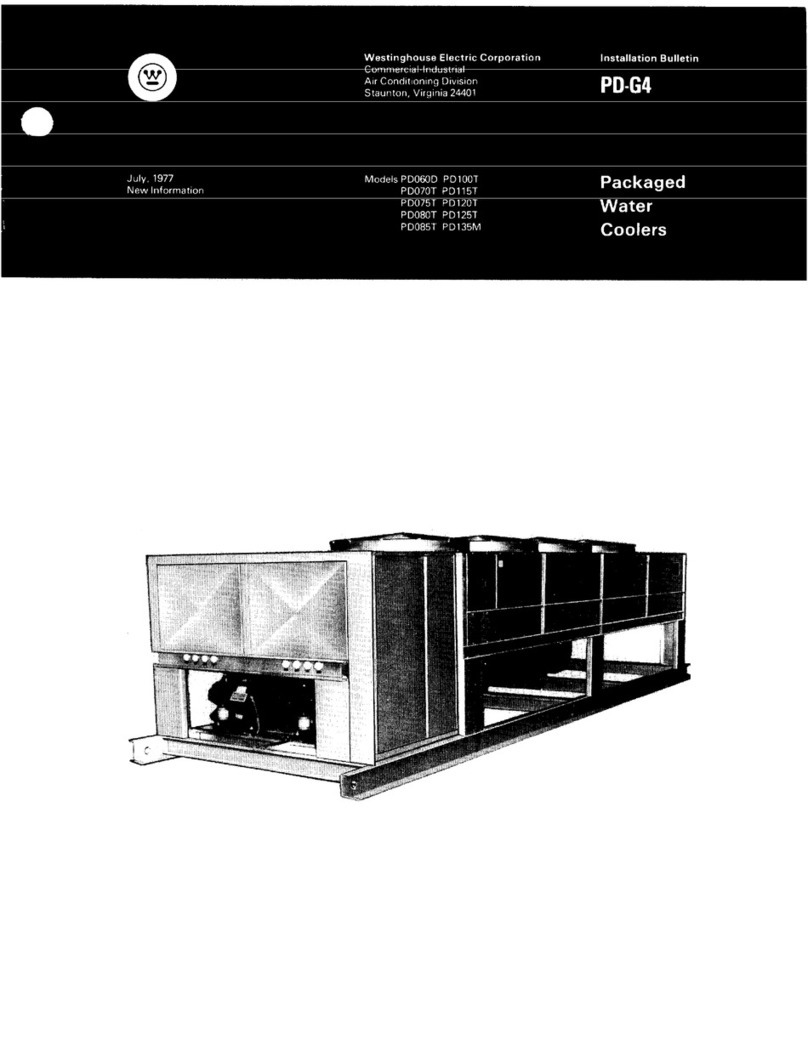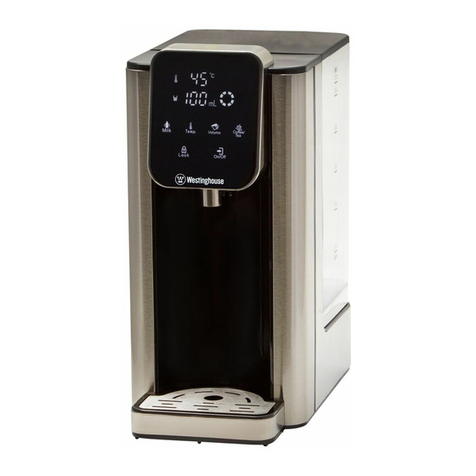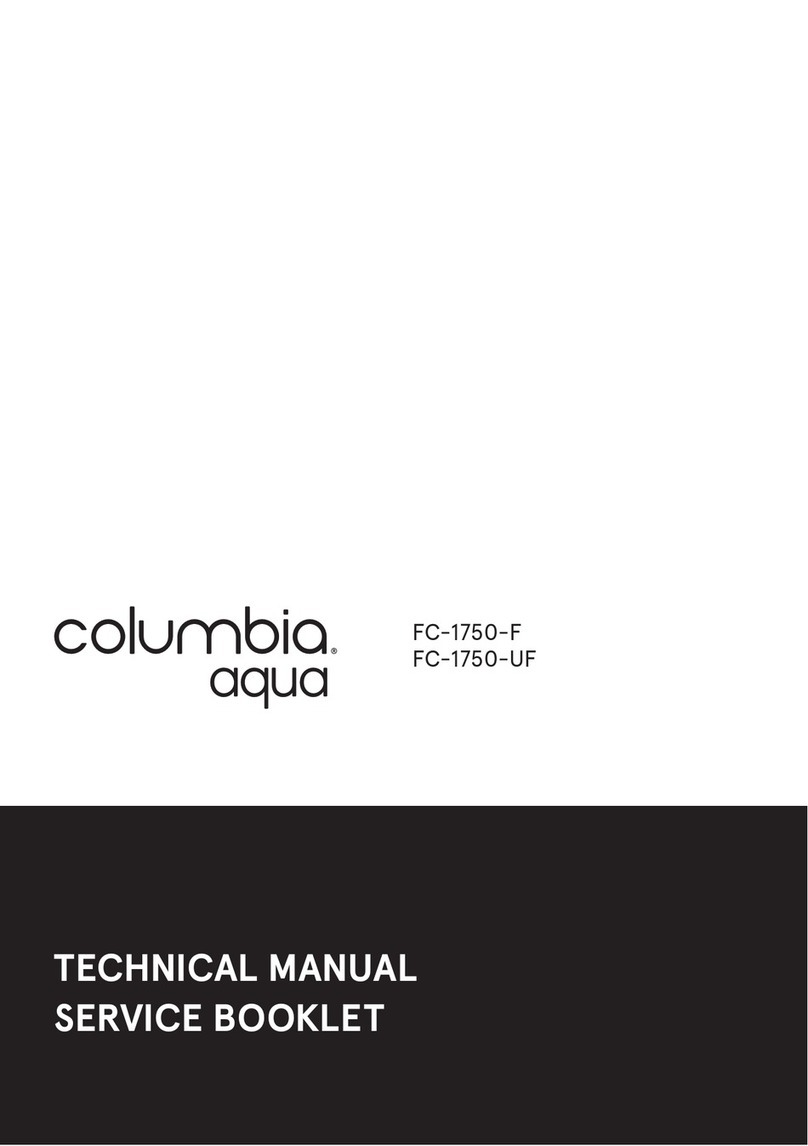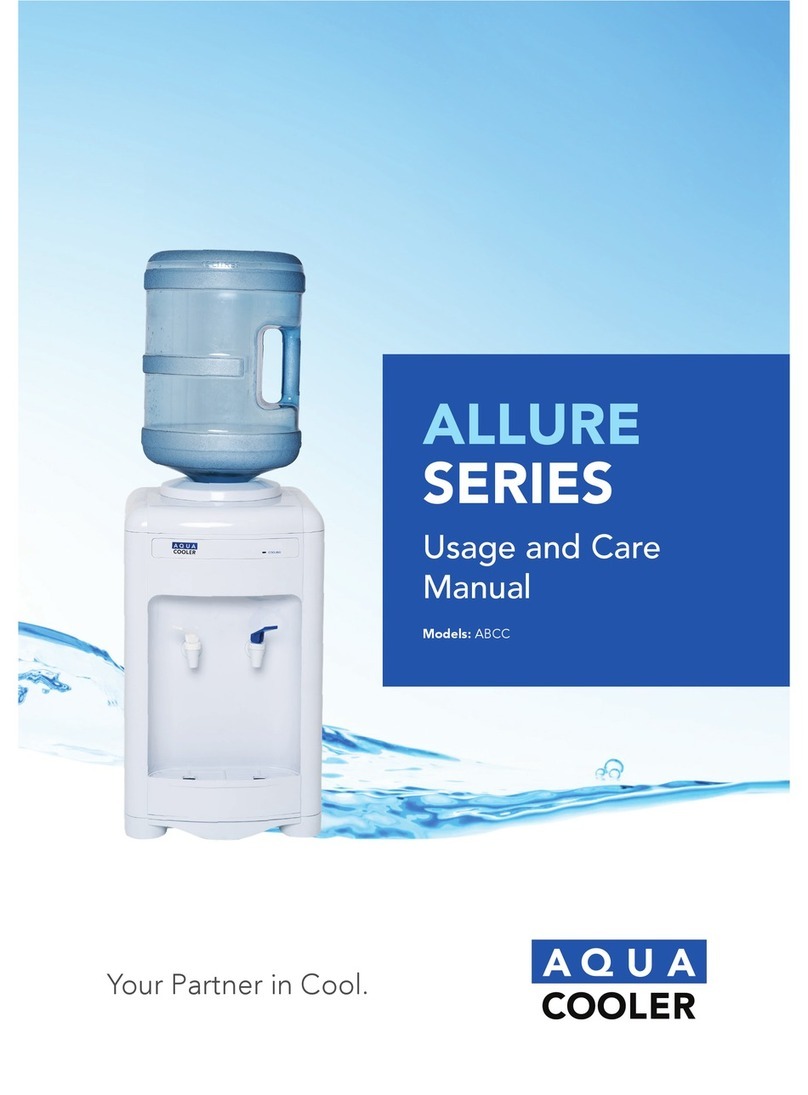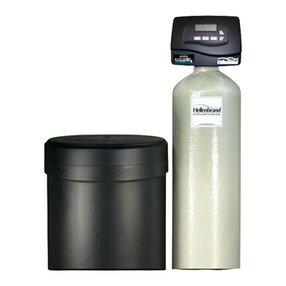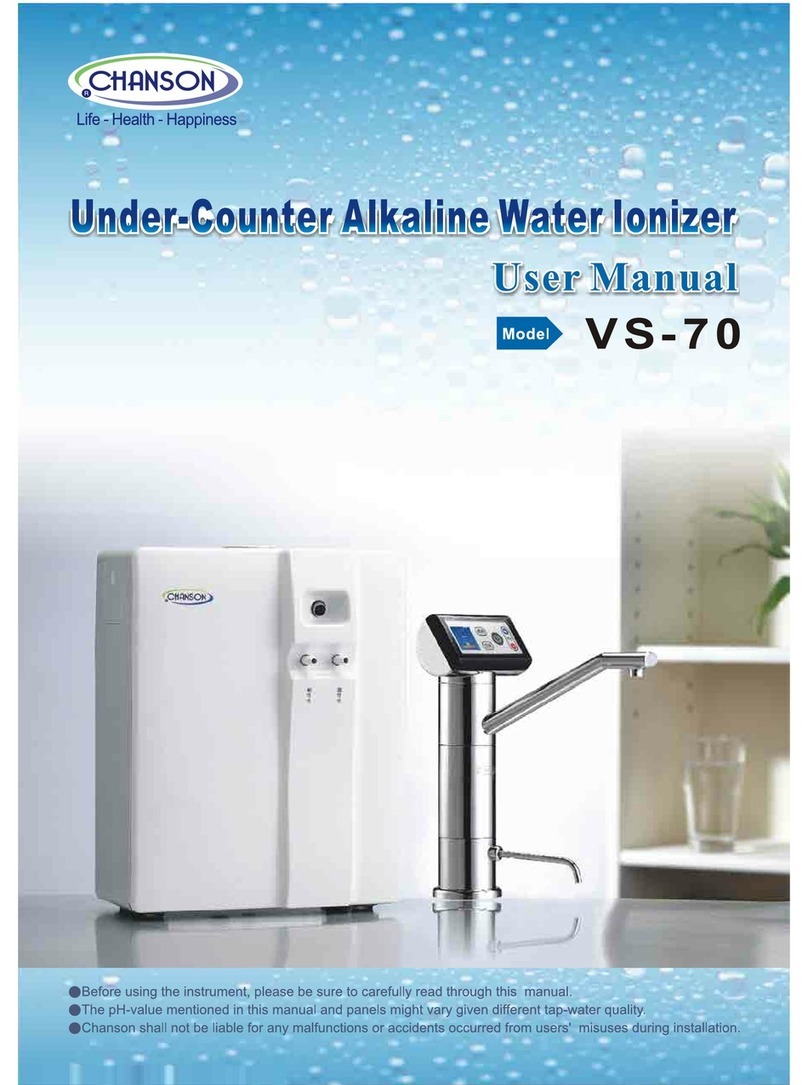Westinghouse WH-1500 Troubleshooting guide

(1)
HOT WATER DISPENSER
Installation & Operating Guide
Record important Hot Water Dispenser information here
Model Number* Serial Number*
Read all instructions thoroughly. Keep this guide for future reference.
Proof of purchase is required for Warranty. Staple receipt or proof of
purchase to this manual for easy reference. Warranty non-transferable.
NOTE: Do not plug appliance into power supply if tank is empty.
IM-WH-1500-221
WH-1500
WARNING:
• This tank is not compatible with InSinkErator faucets
• Do not install in homes with well water
• Westinghouse tanks are vented hot water dispensers and are designed to be used only
with open vent faucets (faucet valve is placed before the tank, creating an “open vent” which
causes no pressure build up inside the tank)
• Westinghouse tanks will have longer life if a water lter with scale inhibitor is attached.
• A drain pan, plumbed to an appropriate drain or outtted with a leak detector, should be
used in those applications where any leakage could cause property damage

(2)
HOT WATER DISPENSER
COMPONENTS:
When you purchase the Westinghouse Water tank, contents include:
1. Quick-connect fitting for water inlet tube
2. Tank
3. 1/4” or 3/8” Hose Clamp
4. Connector/Reducer adapter for 1/4” or 3/8” center outlet tubing
5. 5cm Stainless Steel Tube
6. Mounting Bracket
TYPE OF FAUCET REQUIRED
Only use an “open vent” faucet with the hot water dispenser. Using a standard or reverse type faucet
will damage the tank and void the warranty.
PRESSURE FREE HOT WATER DISPENSER CONCEPT
Unlike other household water dispensers, this dispenser tank is not pressurized for safety reasons.
For a conventional household water heater, the faucet valve is placed after the heater tank resulting
in a pressurized tank. For a hot water dispenser, the faucet valve is placed before the tank, creating
an “open vent” style faucet and consequently no pressure is built up inside the tank.
MATERIAL REQUIRED (NOT PROVIDED)
1. Shut-offvalve and T-union fitting
2. Two mounting bracket screws and plastic support (if attaching to dry wall)
3. 1/4” (6.35mm) O.D. inlet tubing (for areas with freezing climate)
4. Ruler or measuring tape
5. Pliers
6. Hand or electric drill
7. Small drill bit for starter holes
8. 35mm drill bit - if no sink hole exists
9. Gloves
10. Safety glasses
11. Open end wrench
12. Drip pan or bucket
13. Quick Connect fitting for a cold water supply line
IMPORTANT INFORMATION
This hot water dispenser produces instant hot water of approximately 200°F (93°C) ±5° as dispensed
from the faucet. This product is not intended to produce a continuous flow of hot water. This model
will produce up to 60 cups of water per hour at approximately 200°F (93°C) ±5°. Due to high water
temperature, for safety reasons, the tank is not under pressure. Consequently, there is a slight
delay of water flow after the faucet has been turned on. This is normal and indicates that the priming
chamber is functioning properly.

(3)
Electric Shock Hazard: Using an ungrounded or improperly connected appliance can result in
serious injury or death from electrical shock.
This appliance must be grounded. This instant hot water dispenser is equipped with a cord that has
a grounding conductor and a grounding pin. The plug must be connected to an appropriate outlet that
is properly installed and grounded in accordance with all local codes and ordinances. Do not modify
the plug provided with the appliance – if it will not fit the outlet, have a proper outlet installed by a
qualified electrician. Check with a qualified electrician or serviceman if you are in doubt as to whether
the instant hot water dispenser is properly grounded.
Personal Injury: This tank is a non-pressurized tank. DO NOT modify this system. DO NOT close
vent tube or connect other type dispensers or valves to the tank. Use only the Westinghouse
dispenser faucet supplied. Use only parts provided. Contact a certified repair person for repairs or
replacement components.
Fire Hazard: To minimize possibility of fire, DO NOT store flammable items such as rags, paper or
aerosol cans near the tank. DO NOT store or use gasoline or other flammable vapors and liquids in
the vicinity of this or any other appliance.
Property Damage: To avoid water damage, replace any loose or split tubing. Periodically inspect the
unit for any signs of leakage and immediately remove from service any unit suspected of leaking
When using all electrical appliances, basic safety precautions should always be followed including the
following:
1. Do not attempt to service this product. Repairs should be done by authorized service personnel.
2. Do not operate any appliance with a damaged cord, plug, or after the appliance malfunctions.
3. Do not use outdoors or in damp area.
4. Do not let cord hang over edge of table or counter, or touch hot surfaces.
5. Do not use appliance for other than intended household use.
6. When using the appliance, provide 4 to 6 inches of air space around the entire unit for air circulation.
7. To protect against electrical shock, do not place cord, plugs or appliance in water or other liquid.
8. Do not let children operate. The water can cause severe burns.
9. The appliance must not be immersed.
SAVE THESE INSTRUCTIONS.
THIS PRODUCT FOR HOUSEHOLD USE ONLY.
The alert symbols displayed at right point to important safety information to make
you aware of potential hazards that can cause serious injury or death. Please
pay special attention to the information following these alerts and warning.
Failure to comply with these instructions can result in property damage, serious
injury or death.
SAFETY INSTRUCTIONS | Please Read All Instructions Carefully

(4)
ELECTRICAL REQUIREMENTS
Recommended Ground Method
For your personal safety, the hot water dispenser is equipped with a power
supply cord having a 3-prong ground plug. To minimize possible shock hazard,
the cord must be plugged into a mating 3-prong, ground type outlet, grounded in
accordance with all local codes and ordinances.
If a mating outlet is not available, it is the personal responsibility and obligation
of the customer to have a properly ground, 3-prong outlet installed by a qualified
electrician.
If codes permit and a separate ground wire is used, it is recommended that a
qualified electrician determine that the ground path is adequate.
110 volt models:
A 110 volt, 60Hz, AC only 15 or 20 ampere fused, grounded electrical supply is
required. It is recommended that a separate circuit serving only your hot water
dispenser be provided.
220 volt models:
A 220 volt, 50HZ, AC only 10 ampere fused, grounded electrical supply required
within 1 meter distance from the tank.
Note: Use an outlet that cannot be turned on/offby a switch. If the supply cord is damaged, it
must be replaced by the manufacturer, its service agent or similarly qualified persons in order
to avoid a hazard.
INSTALLATION | Before You Begin
IMPORTANT: Make sure that the faucet is compatible to this hot water dispenser. Faucet must be
“open vent” style. Using a standard faucet will damage the tank and void the warranty.
1. Determine where you will install your hot water dispenser. The faucet can be mounted in an
existing hole in the sink, or drill a 1⅜”/35mm hole in your sink. Stainless Steel: You need a
1⅜”/35mm knockout punch available at most hardware stores or drill a hole with an expandable
drill. Porcelain: Proper tools are required to drill through a porcelain or cast iron sink. If you are not
familiar with this process you should consider having this done by a professional plumber.
Do not attempt to drill without these special tools as you may severely damage your sink.
2. Make sure you have all necessary parts, tools as suggested on page 2.
3. Determine a convenient location to mount your faucet. This can be an existing sink hole in the
sink top, or you may drill another hole into the sink. As you determine the location of your faucet,
consider the container you will use with appliance, such as a large cooking pan. Location of the
hole should also provide easy access for tank connections.
4. The thickness of the sink must be less than 2.7”/70mm.
5. Before connecting to the power source, the dispenser must be filled with water and the thermostat
turned to the OFF position.
6. Do not use an extension cord with this appliance. Appliance must be within 36”/914mm of the
power source.
7. Plumbing connections must comply with all local codes and ordinances.
8. Do not use any pipe sealing compounds as they may get inside the dispenser causing an
objectionable taste and odor.
9. The suitable water pressure range for this tank is from 35-100psi.

(5)
STEP 1 - Mounting Tank
Mount tank using the supplied mounting bracket vertically beneath faucet so flexible tube from the
faucet reaches the center faucet supply tube on the tank. Keep the tank .4” (10mm) away from the
wall. DO NOT plug in the power cord during installation.
NOTE: The tank must be positioned so the hose to the faucet does not twist or kink.
STEP 2 -Install Water Filter (Supplied Separately) to incoming water supply line.
Filter Installation Instructions are on the Filter Label. Follow instructions to install then proceed to
Step 3.
IMPORTANT: Observe all governing codes and ordinances.
Tank
must be
mounted
vertically
Quick- connector fittings
connects to cold water
supply line.
See step 4 of installation for optional
connections and instructions
Faucet may be installed in spray hose opening in sink or drilled hole. If drilling another hole is needed, the
13⁄8"/35mm maximum diameter hole is required.
BE SURE DIAL
IS IN OFF
POSITION DURING
INSTALLATION.
4a
4b
Water Filter
STEP 3 - Faucet Installation (Supplied Separately)
Install a faucet as the manual of faucet instructs then proceed to Step 4.
STEP 4 - Connect Faucet to Tank ( Refer to diagram on page #6).
Option 1 - Connect 1/4”/6.35mm faucet inlet line to the quick-connect fitting on the
dispenser. Push line straight into quick-connect fitting as far as possible(4a).
OR
Option 2 - Connect the 5cm stainless steel tube to the quick-connect fitting on
top cover of hot water dispenser. Push the stainless steel tube straight into
quick-connect fitting as far as possible. Connect the 1/4”/6.35mm faucet inlet
line to the stainless steel tube with the quick connect fitting supplied with the
appliance.Push line straight into quick-connect fitting as far as possible until it
stops for both connections. Connect silicone tube to the center outlet tube on
top of tank (4b). Use hose clamp to fix the connection tightly. It will create a
secure connection when properly installed. Be sure the hose is not twisted
or kinked. Hose may be shortened if necessary.
NOTE: DO NOT lengthen the hose - dispenser performance will be impaired and
warranty will be void.

(6)
Center outlet
Connect faucet inlet line to the
rear tube at the top corner of the tank
with the quick-connect fitting
Faucet line connects to the cold
water supply with quick-connect
fitting or compression fitting
(not supplied)
Connect silicone hose to the center
outlet tube on top of tank. Tighten
the connection with ¼” or 3⁄8” hose clamp
Supplied quick-connect fitting
Dual Handle Faucet shown
Faucet line connects to filtered cold
water supply for dual handle faucets
¼” (6.35mm) white tubing to supply inlet
Faucet Image Representational
Connector/Reducer Adapter
Water inlet tube
Instructions are for both single or dual faucets.
STEP 5 - Connect Cold Water Supply
Refer to installation instructions included with faucet if necessary. Cold water is supplied to the tank
through the faucet. Connect the cold water line to the faucet as shown below.
- Make sure the cold water connecting to the faucet is filtered.
- It is suggested that a shut-offvalve be installed between this connection and the cold water supply
line.
- Another common installation method is with the use of a saddle valve. If a saddle valve is used,
follow the manufacturer’s installation guides.
- Connection to a hot water supply is not recommended. If a water filter is used, water pressure to
the tank should not drop below 35psi (2.4 bar).
TYPICAL INSTALLATIONS
"T" connection with
Shut -off valve
T connector
Cold water supply
Shut-off valve
Faucet line
to cold
water
supply
to tank
Silicone hose to
tank
Faucet line
Quick-connect or
Compression fitting
(not supplied - size may vary)
STEP 6 - Check for Leaks
Open valve in water line. Turn faucet on to fill tank (about 1 minute). When tank is full, water will flow
from faucet. Turn faucet off. Check for leaks.
STEP 7 - Prepare for Power
Double check the thermostat control dial is in the OFF position. Thermostat control dial controls the
water temperature, not the water flow or delivery.

(7)
IMPORTANT INFORMATION -
This dispenser is equipped with a self re-setting thermal fuse.
Turn the thermostat to OFF position and fill tank with water before plugging the power
cord from the tank into an electrical outlet.
If tank is empty and the thermostat set in the ON position when the power cord is
connected, the self re-setting fuse in the heater control will disconnect the current to
the heater after approximately one minute, thus protecting the heater from a “dry start”
failure. The fuse in the heater control will self-reset after approximately 1/2 hour. Turn on
the water supply to the tank and continue the installation.
Continued misuse will cause damage to the appliance and is detectable thus, voiding the
warranty.
STEP 8 - Test Installation
Plug electrical cord into a grounded 3-prong outlet. Do not use an outlet controlled by an off/on wall
switch. Turn thermostat control dial clockwise to the highest position. Maximum temperature will be
reached in about 15 minutes and dispenser will be ready for use. Lower the temperature setting by
turning thermostat control dial counterclockwise if you notice vapor or a boiling noise. To raise or
lower the water temperature, rotate the thermostat dial. At the LOW setting of thermostat dial water
temperature will be approximately 140°F (60˚C) ±5° and the HIGH setting of the thermostat dial water
temperature will be approximately 200°F (93°C) ±5°.
CLEANING AND MAINTENANCE | Seasonal
Shutdown
To prevent damage when dispenser is exposed to freezing
temperatures, water must be drained.
1. Unplug dispenser tank to power supply.
2. Turn thermostat control dial to OFF position (fully counter
clockwise).
3. Turn faucet on and run water until water is cold.
4. Prepare a 3 quart container for draining. Put the tank
upside down to drain the water in the tank.
5. Only use mild cleaners to clean the faucet and plastic
components. Cleaners with acids, abrasives, alkaline or
organic solvents will result in deterioration of the plastic
components and void the warranty.
NOTE: Do not plug
appliance into power
supply if tank is empty.

(8)
Regularly inspect the unit for any signs
of leakage. If there are signs of water
damage, immediately remove the unit
from service.
To avoid water damage from leakage,
replace all cut, loose or split tubing .
A drain pan, plumbed to an appropriate
drain or outfitted with a leak detector,
should be used in those applications
where any leakage could cause
property damage.
PROPERTY DAMAGE
Only use mild cleaners to clean the
faucet and plastic components.
Cleaners with acids, abrasives,
alkaline or organic solvents will
result in deterioration of the plastic
components and void the warranty.
CLEANING THE FAUCET AND TANK
Scalding Hazard: Do not allow
water to boil. May result in
severe burns.
Factory temperature pre-set
is ÛF 5ÛF.
the indicator two notches
to the right of vertical.
Adjust the thermostat
slowly, turning the dial
clockwise to increase temperature
or counter clockwise to decrease
temperature, then activate faucet
handle for 20 seconds to bring in fresh
water to be heated at the new setting.
Allow 5-7 minutes for water to reach
new temperature.
approx. 194°
ADJUSTING THE THERMOSTAT
To reset the
+
-
thermostat to that setting, turn
For fresher tasting
water, add filtration
to your instant hot
water dispenser
system. For more
information, call
1-888-856-6322
(USA & CANADA)
Electric Shock Hazard. To prevent electrical shock, disconnect power before
servicing unit. Use only a properly grounded and polarzed electric outlet.
CARE AND USE

(9)
TROUBLESHOOTING
WHAT TO DO
Water and steam spits
forcefully from spout
without turning on the
dispenser faucet.
Water is not hot.
• Unit is boiling.
May be normal during initial setup.
• The unit is unplugged.
• The electric outlet is inoperative.
•
Activate faucet lever to release some water from
the tank.
• Adjust water temperature using dial on tank front.
Remember that at higher altitudes, water boils
at lower temperatures.
•
Make sure the unit is connected to a properly grounded
electric outlet.
• Make sure the circuit breaker or fuses are
functioning properly.
• Check that the outlet is not switched off.
Water is too hot
or not hot enough.
• Thermostat is not adjusted to
your needs.
•
Adjust the thermostat slowly, then activate faucet lever for 20
seconds to bring in fresh water to be heated at the new setting.
Allow 5-7 minutes for water to reach new temperature.
Water comes out the
vent instead of spout.
• Outlet tube is blocked
Check that outlet tube is not kinked, twisted or pinched.
•
Unscrew spout end piece and clean out any debris.
Water is dripping from
the spout/vent
intermittently.
• The expansion chamber isn’t
draining properly due to low
water pressure.
• The spout is blocked.
• Unplug the unit. If the dripping doesn’t stop after a few
minutes, check the supply valve to ensure that is fully
open and there are no obstructions in the water line
reducing the pressure below 30 psi, (
a poorly mounted
saddle valve, a clogged water filter, or a partially opened
shut-off valve).
•
Unscrew spout end piece and clean out any debris.
PROBLEM POSSIBLE CAUSE
•
• Turn thermostat control dial fully clockwise. This may
produce boiling water in approximately 15 minutes and
possibly be accompanied by a gurgling sound in the tank
and/or water “sputtering” from the faucet. If the water
boils, turn thermostat control dial slightly
counterclockwise until the gurgling and/or “sputtering”
stops. This should take place within 20 seconds. Turn
control dial an additional 1/8” (3 mm) counterclockwise at
the tip of the dial. Wait 15 minutes and check the
temperature of the water.
IF TROUBLE PERSISTS CALL 1-888-856-6322 USA & CANADA

(10)
WHAT TO DOPROBLEM POSSIBLE CAUSE
continued:
Water does not
flow right away
or at all:
• Due to high temperature and
for safety reasons, the tank is
not under pressure causing a
slight delay in water flow.
• Make sure all valves on water supply are open.
• Check hose from faucet for twisting or tight bending.
• Check if quick-connect filter screen or faucet filter
screen is clogged (see faucet manual).
Water boils or
vapor appears: • The thermostat may be set
too high.
• Lower temperature setting by turning thermostat
control dial counterclockwise.
Hot water drips
or sputters from
faucet:
• The thermostat may be set
too high.
• Turn thermostat control dial counterclockwise.
• Check that the hose connecting the faucet to the
dispenser tank is not clogged, twisted or kinked.
• If quick-connect fitting is connecting cold water supply,
check for a clogged filter screen in quick-connect fitting
(see CLEANING AND MAINTENANCE of faucet
manual).
• Check for proper installation of tubing from faucet to
dispenser tank and faucet to water line. If connected
backwards or cross-connected, valve may be
damaged.
Customer Service:
Joneca Company, LLC.
4332 E. La Palma Avenue Anaheim, California 92807
Telephone: 714.993.5997 Fax: 714.993.2126
Website: www.Joneca.com
E-Mail: [email protected]
Toll Free Help Line (USA & CANADA)
1-888-856-6322
, WESTINGHOUSE, and
INNOVATION YOU CAN BE SURE
OF are trademarks of Westinghouse
Electric Corporation. Used under
All Rights Reserved.
license by Joneca Company, LLC.
Table of contents
Other Westinghouse Water Dispenser manuals
Popular Water Dispenser manuals by other brands
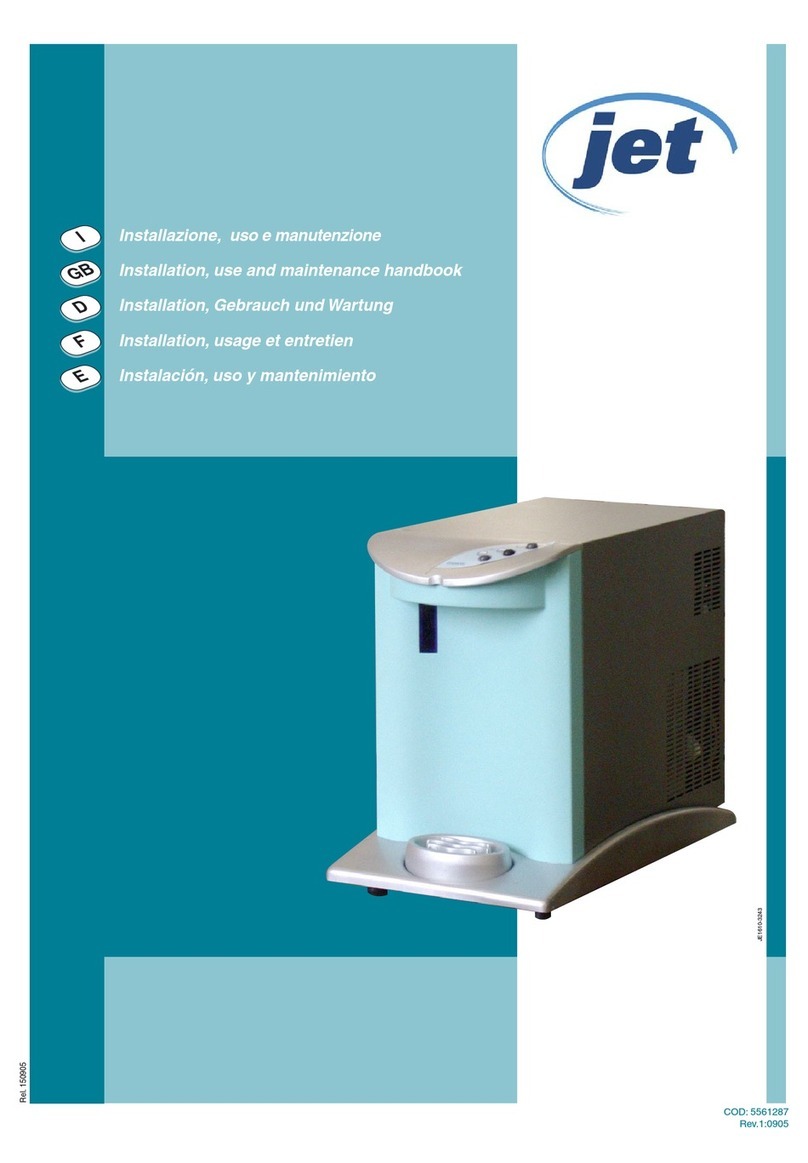
Foster
Foster CTDWC25 Installation, use and maintenance handbook

Honeywell
Honeywell HWB2052 Series owner's manual
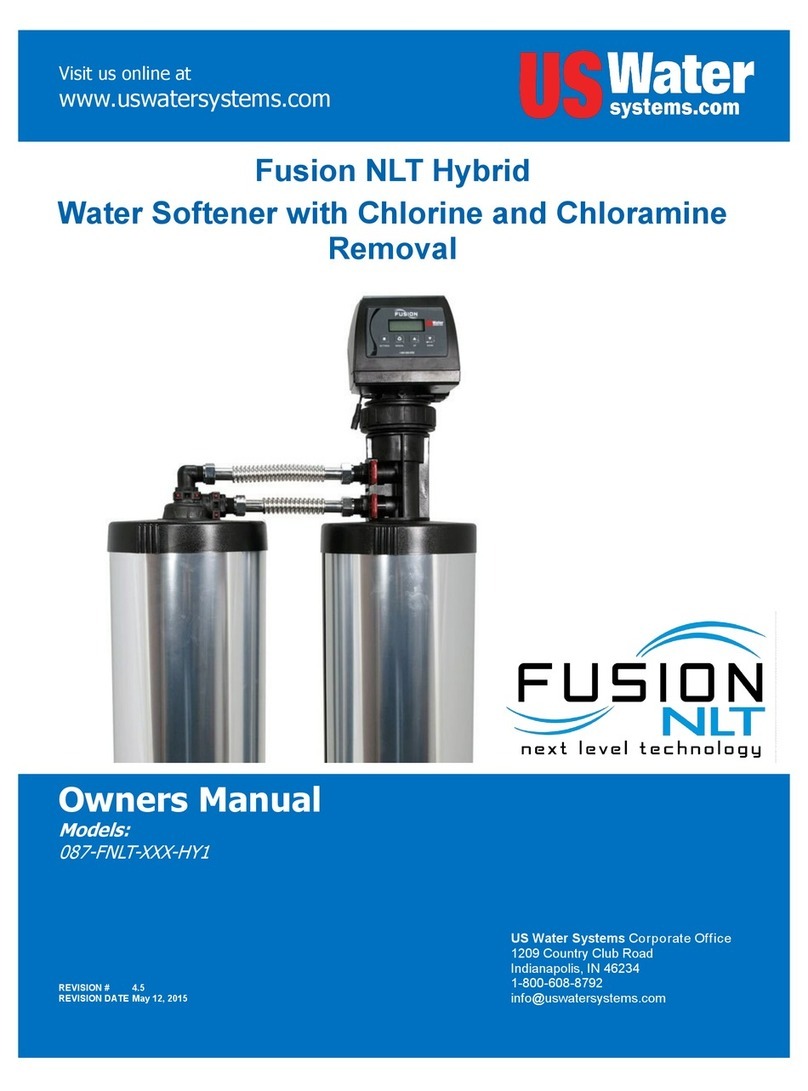
US Water Systems
US Water Systems FNLT-100-HY owner's manual
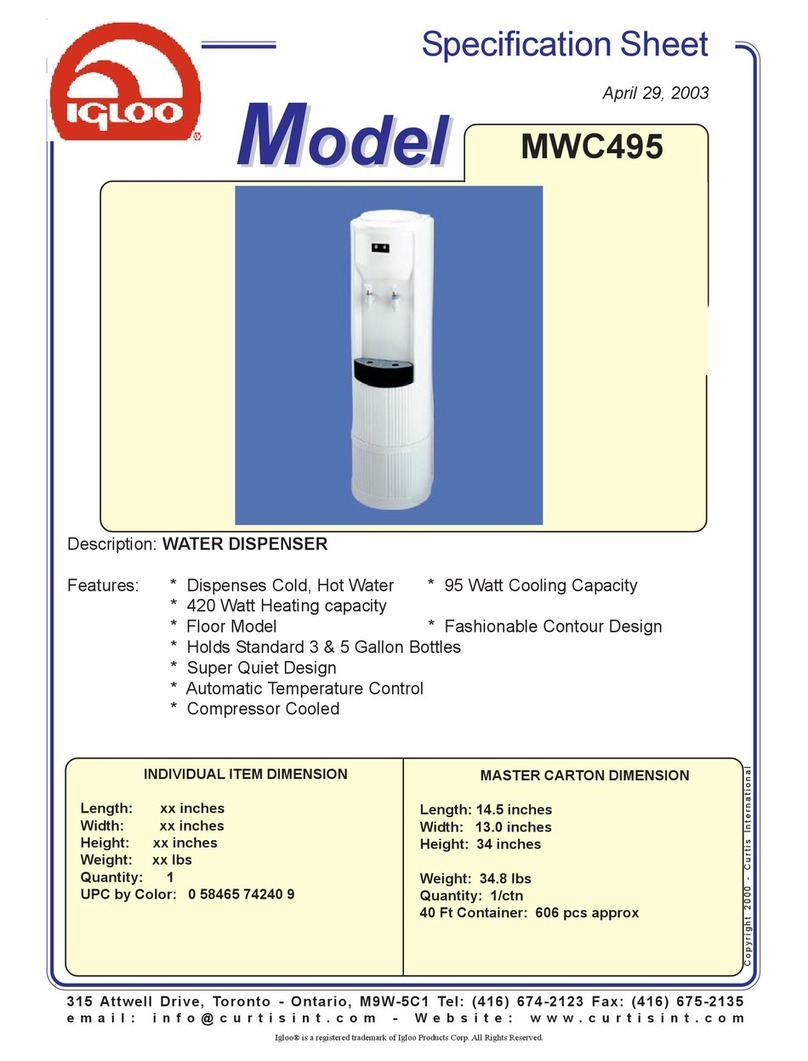
Igloo
Igloo MWC495 Specification sheet
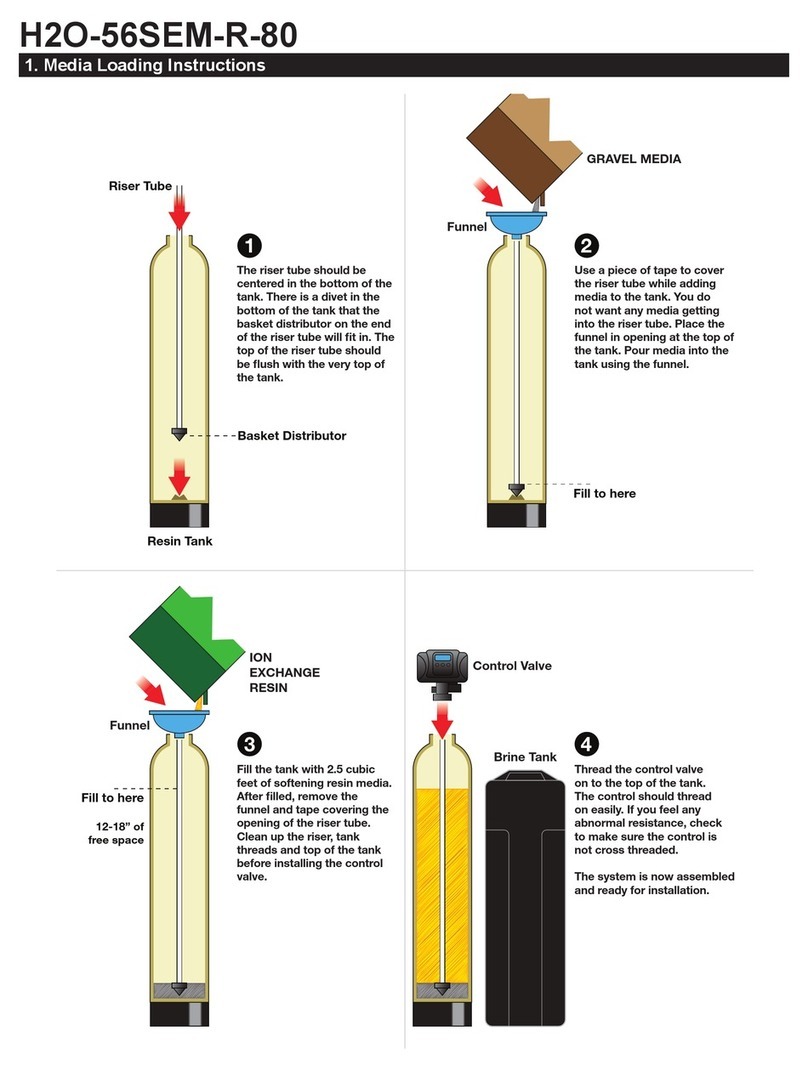
H2O
H2O H2O-56SEM-R-80 instructions

GE
GE GXSF30V02 Owner's manual and installation instructions

Everpure
Everpure CG53-20 Specification sheet

BRAVILOR BONAMAT
BRAVILOR BONAMAT Chill-002 operating instructions

Aqua Essentials
Aqua Essentials Borg & Overstrom B2 user guide
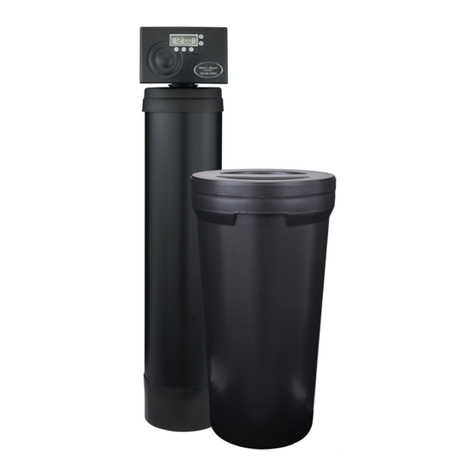
Water Depot
Water Depot Deluxe Series owner's manual
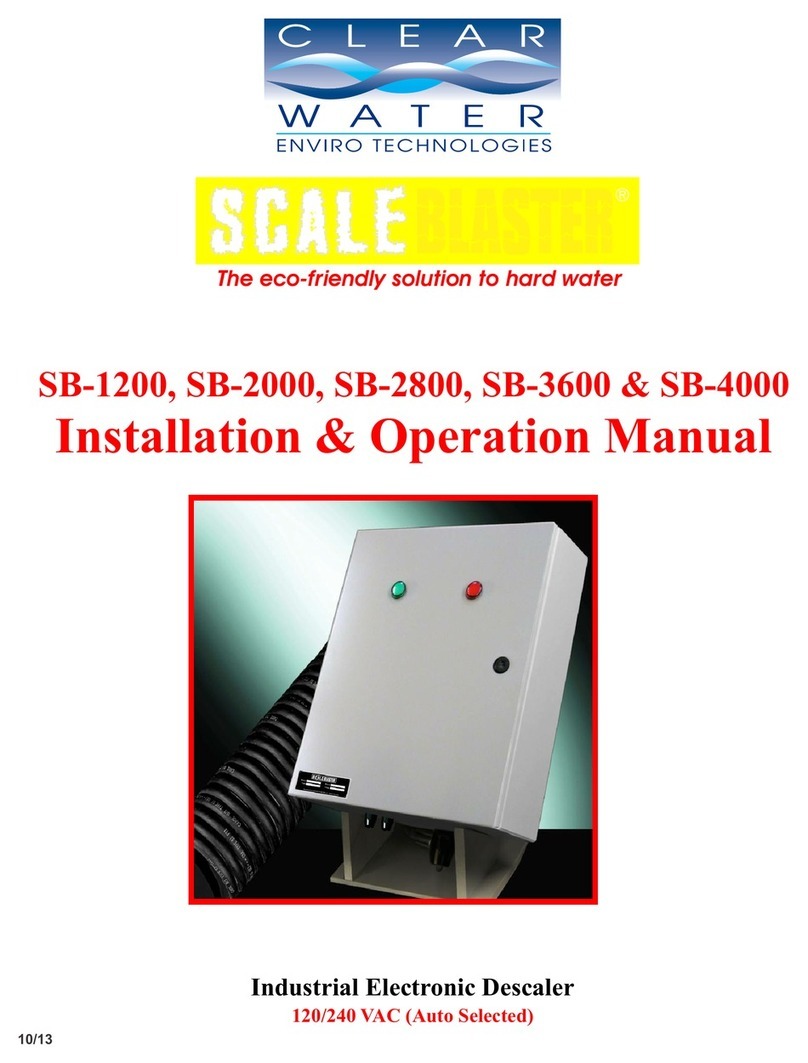
ScaleBlaster
ScaleBlaster SB-1200 Installation & operation manual
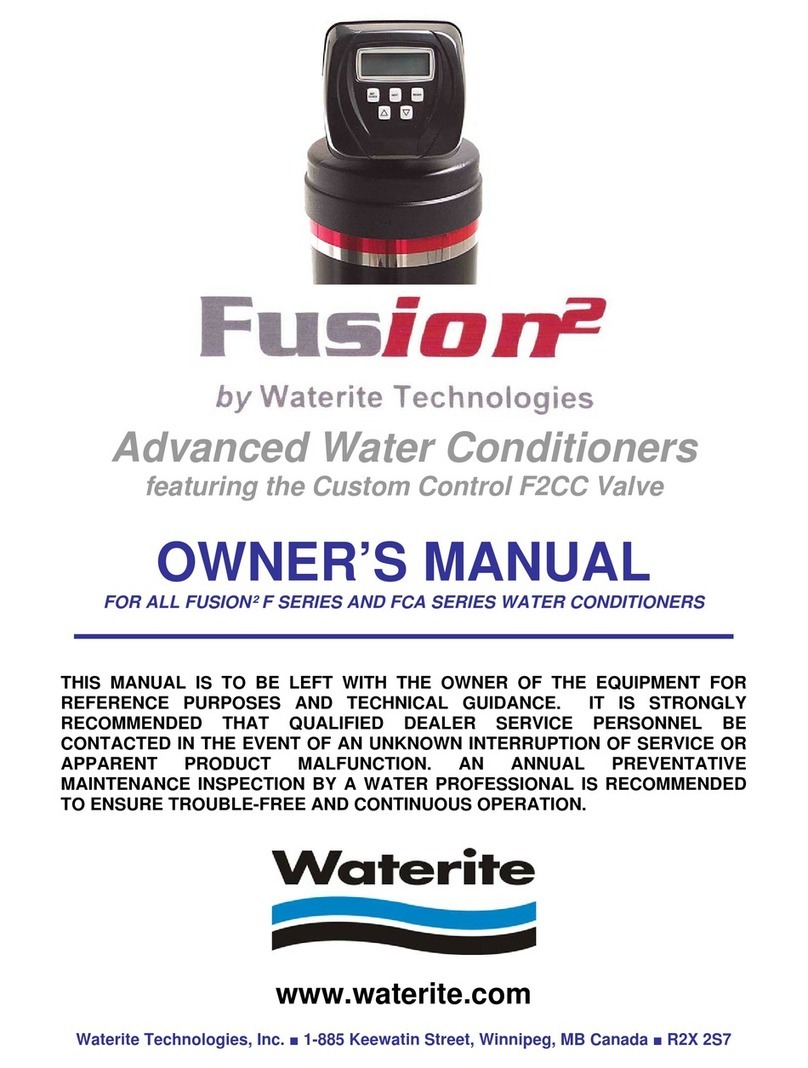
Waterite
Waterite FUSION2 F Series owner's manual

